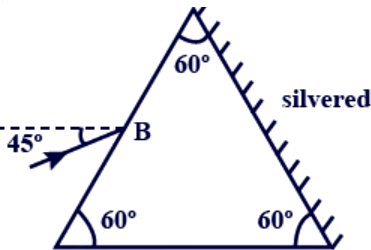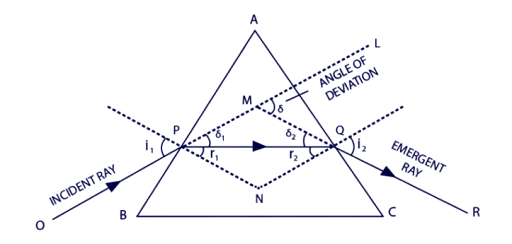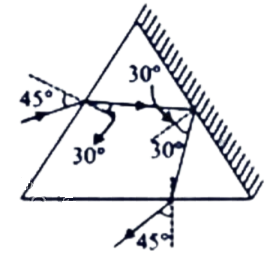
An equilateral prism is made of a transparent material of refractive index 2.A ray of light AB is incident at 45 as shown. The net derivation in the path of the ray when it comes out of prism is?

A. 135°
B. 120°
C. 30°
D. 150°
Answer
218.7k+ views
Hint: In this question we will use the concept of deviation in the path of a ray due to refraction at the surfaces of a prism. Since the speed of the media changes, the difference in their refractive indices causes the phenomenon of refraction to happen. This alteration in speed causes the ray's direction to change.
Formula used:
The expression of refractive index is,
\[\mu =\dfrac{\sin (i)}{\sin ({{r}_{1}})}\]
Here, $i$ is the angle of incidence and $r_1$ is the angle of refraction.
Complete step by step solution:
Let us name the triangle as PQR. The side where AB ray hits is PQ and the silvered side is PR.
Since the triangle is equilateral all the angles of the triangle are equal to 60°.

In the image above, i=incident angle, $r_1$=refractive angle of surface PQ, $r_2$= refractive angle of surface PR, e=angle of emergence and δ=total angle of deviation.
The incident ray AB when entering the prism, it is traveling from a rarer medium to a denser medium. Therefore, the ray will bend towards the normal of the PQ surface.
The relation between i, $r_1$ and μ(refractive index) is:
\[\mu =\dfrac{\sin (i)}{\sin ({{r}_{1}})}\]
$\Rightarrow \sqrt{2}=\dfrac{\sin (45)}{\sin ({{r}_{1}})}$
$\Rightarrow \sin ({{r}_{1}})=\dfrac{1}{2}$
$\Rightarrow {{r}_{1}}={{30}^{\circ }}$
Since $r_1$=30°, the refractive ray became parallel to the base.
By geometry, $r_1+r_2$=angle of the triangle
$\Rightarrow {{30}^{\circ }}+{{r}_{2}}={{60}^{\circ }}$
$\Rightarrow {{r}_{2}}={{30}^{\circ }}$
In the given question, side PR is silvered. Therefore, the refracted ray parallel to the base of
the triangle will reflect. Since angle of incidence for the mirror is 30°, angle of reflection is also equal to 30°.
Total deviation at the reflective surface = 30°+30°=60°
The ray diagram is given below.

Now, the reflective ray will hit the surface QR at 30° to the normal.
The emergence ray is traveling from a denser medium to rarer medium.
According to the formula:
\[\mu =\dfrac{\sin (i)}{\sin ({{r}_{1}})}\]
$\Rightarrow \sqrt{2}=\dfrac{\sin ({{30}^{\circ }})}{\sin (e)}$
$\Rightarrow \sin (e)=\dfrac{\sin ({{30}^{\circ }})}{\sqrt{2}}$
$\therefore e={{45}^{\circ }}$
Total deviation = (45° -30°) + (180° -60°) + (45° -30°) = 150° clockwise.
Hence, the correct answer is D.
Note: By geometry, $r_1+r_2$=angle of the triangle. The angle of emergence is not equal to angle $r_2$ since refraction will happen. When a ray is traveling from a rarer medium to a denser medium, the ray will bend towards the normal. When a ray is traveling from a denser medium to a rarer medium, the ray will bend away from the normal.
Formula used:
The expression of refractive index is,
\[\mu =\dfrac{\sin (i)}{\sin ({{r}_{1}})}\]
Here, $i$ is the angle of incidence and $r_1$ is the angle of refraction.
Complete step by step solution:
Let us name the triangle as PQR. The side where AB ray hits is PQ and the silvered side is PR.
Since the triangle is equilateral all the angles of the triangle are equal to 60°.

In the image above, i=incident angle, $r_1$=refractive angle of surface PQ, $r_2$= refractive angle of surface PR, e=angle of emergence and δ=total angle of deviation.
The incident ray AB when entering the prism, it is traveling from a rarer medium to a denser medium. Therefore, the ray will bend towards the normal of the PQ surface.
The relation between i, $r_1$ and μ(refractive index) is:
\[\mu =\dfrac{\sin (i)}{\sin ({{r}_{1}})}\]
$\Rightarrow \sqrt{2}=\dfrac{\sin (45)}{\sin ({{r}_{1}})}$
$\Rightarrow \sin ({{r}_{1}})=\dfrac{1}{2}$
$\Rightarrow {{r}_{1}}={{30}^{\circ }}$
Since $r_1$=30°, the refractive ray became parallel to the base.
By geometry, $r_1+r_2$=angle of the triangle
$\Rightarrow {{30}^{\circ }}+{{r}_{2}}={{60}^{\circ }}$
$\Rightarrow {{r}_{2}}={{30}^{\circ }}$
In the given question, side PR is silvered. Therefore, the refracted ray parallel to the base of
the triangle will reflect. Since angle of incidence for the mirror is 30°, angle of reflection is also equal to 30°.
Total deviation at the reflective surface = 30°+30°=60°
The ray diagram is given below.

Now, the reflective ray will hit the surface QR at 30° to the normal.
The emergence ray is traveling from a denser medium to rarer medium.
According to the formula:
\[\mu =\dfrac{\sin (i)}{\sin ({{r}_{1}})}\]
$\Rightarrow \sqrt{2}=\dfrac{\sin ({{30}^{\circ }})}{\sin (e)}$
$\Rightarrow \sin (e)=\dfrac{\sin ({{30}^{\circ }})}{\sqrt{2}}$
$\therefore e={{45}^{\circ }}$
Total deviation = (45° -30°) + (180° -60°) + (45° -30°) = 150° clockwise.
Hence, the correct answer is D.
Note: By geometry, $r_1+r_2$=angle of the triangle. The angle of emergence is not equal to angle $r_2$ since refraction will happen. When a ray is traveling from a rarer medium to a denser medium, the ray will bend towards the normal. When a ray is traveling from a denser medium to a rarer medium, the ray will bend away from the normal.
Recently Updated Pages
A square frame of side 10 cm and a long straight wire class 12 physics JEE_Main

The work done in slowly moving an electron of charge class 12 physics JEE_Main

Two identical charged spheres suspended from a common class 12 physics JEE_Main

According to Bohrs theory the timeaveraged magnetic class 12 physics JEE_Main

ill in the blanks Pure tungsten has A Low resistivity class 12 physics JEE_Main

The value of the resistor RS needed in the DC voltage class 12 physics JEE_Main

Trending doubts
JEE Main 2026: Application Form Open, Exam Dates, Syllabus, Eligibility & Question Papers

Derivation of Equation of Trajectory Explained for Students

Hybridisation in Chemistry – Concept, Types & Applications

Understanding the Angle of Deviation in a Prism

Understanding Collisions: Types and Examples for Students

Understanding Atomic Structure for Beginners

Other Pages
JEE Advanced Marks vs Ranks 2025: Understanding Category-wise Qualifying Marks and Previous Year Cut-offs

How to Convert a Galvanometer into an Ammeter or Voltmeter

Understanding Centrifugal Force in Physics

JEE Main Marking Scheme 2026- Paper-Wise Marks Distribution and Negative Marking Details

Degree of Dissociation: Meaning, Formula, Calculation & Uses

Understanding Electromagnetic Waves and Their Importance




